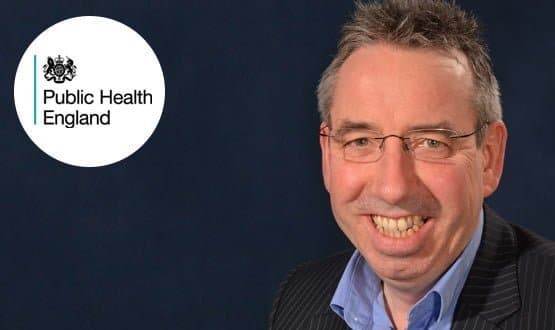EHI interview: Duncan Selbie
- 19 February 2014

It may be called the National Health Service, but the truth is that the NHS focuses on illness, not wellness.
Duncan Selbie points out that while studies have shown that health care does not contribute more than 20% to the definition of person’s ‘good health’, this is where the vast majority of health spending is directed.
Public Health England is one of the organisations charged with bridging the gap between health care and good health by looking at “how as a whole system we work to improve the public’s health.”
“Our role here is to help the nation come to understand better what we mean by good health because it’s not synonymous with the NHS,” Selbie explains.
Making it relevant
Public Health England has its origins in the ‘Liberating the NHS’ white paper written by former health secretary Andrew Lansley. In opposition, he toyed with the idea of abolishing the Department of Health and replacing it with a new, public health body.
But the outcome of his reforms was a slimmed down DH, operating alongside the new PHE, which formally started work on 1 April last year.
On its website, it says its “mission is to protect and improve the nation’s health and to address inequalities”, by encouraging debate, working with councils, industry and others to deliver public health improvements, running the Health Protection Service, and dealing with emergencies.
A good deal of the PHE’s website is currently taken up with information about floods and how to deal with them without getting sick. But that’s far from the limit of its ambition.
Selbie, who has worked in NHS management since 1980, most recently as chief executive of Brighton and Sussex University Hospitals NHS Trust, points out that the NHS is not only focused on treating illness, but “pieces of the system” where things have gone wrong.
So, he argues, the NHS has faced up to the ‘Nicholson Challenge’ to bridge the gap between flat income and rising demand. But it has focused on tariffs and pay deals, rather than on where the extra demand is coming from and what can be done to stop people becoming unwell.
Along the way, this has contributed to problems such as those uncovered at Mid Staffordshire NHS Foundation Trust, which has led to a burst of regulatory activity but, again, relatively little attention on why people are in hospital in the first place.
Meanwhile, the risk factors that affect nearly all long-terms conditions and cause illness remain unchanged. Selbie acknowledges that while they are “stunningly unoriginal” – since they include tobacco and alcohol consumption, diet and regular exercise – collectively they have a “huge impact”.
Digital helps
“How does digital opportunity help us with this?” Selbie muses during his interview with EHI. “The biggest contributor to the choices people make, and [so to many of the factors driving health inequality] is ‘how broad are your choices?’
“The choices people are making are not influenced by telling them not to or poster campaigns, but how you reach them in relevant and meaningful ways; and this is not something we have been doing in health before.”
PHE is trying a number of digital approaches to getting at people in “relevant and meaningful ways”, and has some success stories it can cite.
For example, it is running a ‘Longer Lives’ website that allows people to see how their local area performs with regards to mortality rates, in comparison to the rest of the country. The site had thousands of hits a week when it launched in June last year, and still attracts significant traffic.
Selbie also points to the success of digital campaigns such as Stoptober, which encouraged people to stop smoking, and which involved 200,000 people downloading a supporting app in 2013. The ‘Change for Life’ campaign also has 1m families signed up the healthy diet work.
“When I say we need to go digital, it’s not that we aren’t digital, but my hope is to get into the behavioural sciences and combine them with the digital opportunity to reach people,” Selbie explains.
He wants PHE to work with different organisations that already reach large numbers of people and use its expertise in things like algorithms to create apps that help them make healthier choices in their lives.
Supermarkets could be used to help people make better decisions about the foods they buy such as salt and fat levels, or PHE could work with faith groups or private companies such as Nike, which are already “relevant to people”.
“Where you reach people is where we need to be thinking hardest, it’s about digital meets the behavioural sciences,” Selbie adds.
The digital journey
John Newton, PHE’s chief knowledge officer, says the NHS needs local authorities and others to promote health and wellbeing or it will not be able to cope with the demand on health services.
“We have to improve prevention across the board,” he says. “And a huge amount of what we do is potentially promoted by digital.
Key to this is getting people to engage and interact, rather than be passive recipients of health messages.
“Whatever you do, if it’s going to have any impact in a public health sense, it has to be done at scale and digital allows you to do that and allows people to engage with you,” Newton explains.
“That’s why we are so excited by digital, because our knowledge information and research can be enabled digitally and our advocacy work is incredibly powerful digitally.”
One of the key things the organisation wants to do is improve its website, starting with an understanding of what its users want.
It is also working closely with NHS Choices and plans to put all of its public facing material directly on the site. Its various tools are currently linked to from Choices, but will be hosted directly on the new Health and Social Care Digital Service when it goes live.
“We are working with Choices so we are going to put more data on there about risks of things like cancers and we are already part of the planning team for the successor to Choices with the HSCIC,” Newton says.
“What we don’t think is particularly helpful is posting very large files on the Internet. What people need is information in a context so they can use it and explanation so they can understand it.
“At the moment we are scoping out our strategy, but we want to get in a position where people consider digital media first and people prefer to use our digital communications rather than paper.”
Time to grab the digital generation
He believes the health sector has been slow to embrace digital and wants PHE to be seen as a leader, arguing that the organisation lends itself well to this because it is open facing, knowledge based and needs to operate at scale.
“There’s plenty of knowledge out there need to make it available in the right place and in the right format for people to use it. For that you need good digital design and we want to attract the best people to work with us,” Newton says.
“If we are not active in the digital space we are going to miss a whole generation of people who are growing up.”
Hear more from Selbie and Newton on the latest EHI Podcast.



